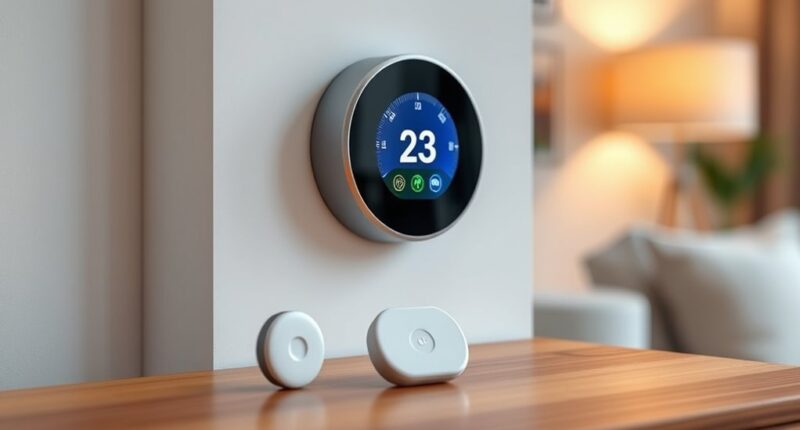If you’re looking for the top smart thermostats with remote sensors, I recommend options like the ecobee SmartThermostat Premium and Honeywell T9, which offer room-specific temperature control and compatibility with various smart home systems. These models help boost comfort and cut energy costs by adjusting settings based on occupancy and room conditions. Their sleek designs and easy installation make them perfect for modern homes. Keep exploring to find the perfect fit for your climate and budget.
Key Takeaways
- Many top smart thermostats support multiple remote sensors for precise room-by-room climate control.
- Features like occupancy detection and multi-sensor setups enhance energy efficiency and comfort.
- Compatibility with popular smart home platforms ensures seamless automation and remote management.
- Sensor integration helps optimize HVAC usage, reducing energy bills and maintaining consistent temperatures.
- User-friendly controls, easy installation, and advanced features make these thermostats ideal for modern smart homes.
Honeywell Home T9 WiFi Smart Thermostat
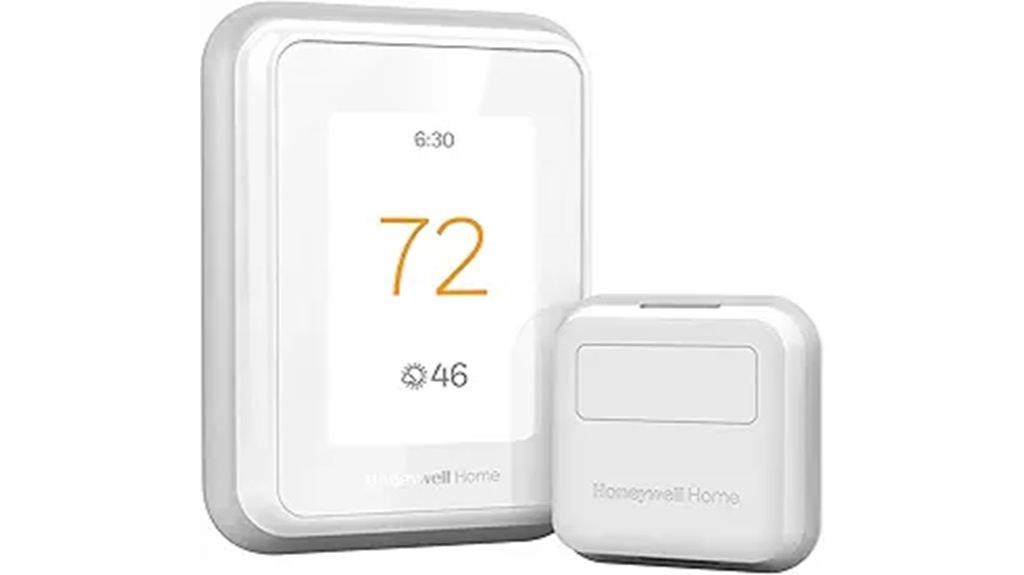
If you’re looking for a smart thermostat that offers precise control over different rooms, the Honeywell Home T9 WiFi Smart Thermostat is an excellent choice. It features a sleek touchscreen display and works with Wi-Fi, Amazon Alexa, Apple HomeKit, and Google Assistant. With Smart Room Sensors, it detects temperature and humidity up to 200 feet away, allowing me to customize comfort in individual rooms like bedrooms or offices. The system balances temperatures based on occupancy and schedules, helping me save energy and money. Easy to install with guided setup, it also supports remote management via the Honeywell Home app, making home comfort effortless and efficient.
Best For: homeowners seeking precise, customizable temperature control across multiple rooms with smart technology integration.
Pros:
- Supports multiple smart home platforms including Alexa, Apple HomeKit, and Google Assistant
- Allows individual room temperature adjustments via Smart Room Sensors for personalized comfort
- Easy DIY installation with guided setup and remote management through the Honeywell Home app
Cons:
- Does not work with electric baseboard heating (120-240V)
- Requires a C-wire or included low-voltage power adapter for installation
- Battery-powered sensors may need replacement over time
ecobee Smart Thermostat Premium with Sensors and Air Quality Monitor

The ecobee Smart Thermostat Premium with Sensors and Air Quality Monitor stands out as an ideal choice for homeowners seeking precise temperature control combined with enhanced air quality monitoring. It offers up to 26% annual energy savings, is ENERGY STAR certified, and features a vibrant LCD display with a cinematic interface. Compatible with most 24VAC HVAC systems, it includes a Power Extender Kit for wire-free homes. The SmartSensor adjusts temperature in key rooms, while the built-in air quality monitor alerts you to poor air and filter needs. With occupancy sensing, safety features like smoke detection, and smart integrations, it’s a thorough solution for comfort, efficiency, and safety.
Best For: homeowners seeking precise temperature control, improved air quality, and energy savings with smart home integration.
Pros:
- Up to 26% annual energy savings and ENERGY STAR certification for eco-friendly operation
- SmartSensor and built-in air quality monitor enhance comfort and health monitoring
- Compatible with multiple voice assistants and smart home platforms for seamless control
Cons:
- Requires an Apple home hub for Siri integration, adding to setup complexity
- May be more expensive than basic thermostats due to its advanced features
- Installation can be challenging for DIYers without professional assistance
Sensi Touch 2 Smart Thermostat with Touchscreen Display

For homeowners seeking precise temperature control across different rooms, the Sensi Touch 2 Smart Thermostat with Touchscreen Display is an excellent choice. It features a sleek 5.6-inch LCD touchscreen, Wi-Fi connectivity, and supports programmable schedules, remote control, and geofencing for personalized comfort. Compatible with most HVAC systems in the U.S. and Canada, it requires a C-wire for installation. You can use the Sensi Room Sensors (sold separately) to balance temperatures across rooms. Easy to install with an app that guides setup via Bluetooth, it supports voice commands and offers energy-saving reports, making it a versatile, user-friendly option.
Best For: homeowners seeking easy installation, customizable comfort, and energy efficiency through smart, remote-controlled temperature management.
Pros:
- Supports programmable schedules, remote access, and geofencing for personalized comfort and energy savings
- Easy DIY installation guided by an app with Bluetooth setup, no guesswork required
- Compatible with a wide range of HVAC systems and integrates with voice assistants like Alexa, Google Assistant, and SmartThings
Cons:
- Requires a common (C) wire for installation; not suitable for systems without one
- Does not include batteries; relies on C-wire power connection only
- Sensi Room Sensors are sold separately, adding extra cost for room-specific temperature balancing
Smart WiFi Thermostat with Room Sensor and Touchscreen

A smart WiFi thermostat with a room sensor and touchscreen is ideal for homeowners seeking precise temperature control and energy savings. I love how the Provirtec TH-01 supports over 95% of 24VAC HVAC systems, including central air, heat pumps, boilers, and furnaces. Its large 3.95-inch LED touchscreen makes adjusting settings intuitive, while the app allows remote control. Features like auto-away, sleep, and body location-based detection help optimize comfort and reduce energy waste. Plus, it remains operational during internet outages, switching to local control. Installation is straightforward, and compatibility with a smart thermo-hygrometer adds real-time monitoring, making this thermostat both smart and versatile.
Best For: homeowners seeking a versatile, energy-efficient smart thermostat compatible with most 24VAC HVAC systems, offering precise control and remote management.
Pros:
- Supports over 95% of 24VAC HVAC units including central air, heat pumps, boilers, and furnaces
- Large 3.95-inch touchscreen for easy, intuitive control and clear display
- Maintains operation during internet outages by switching to local control
Cons:
- Customer reviews average only 3.7 stars, indicating mixed feedback on performance or usability
- Requires WiFi for full functionality, which may limit features during connectivity issues
- Additional components like thermo-hygrometers are optional and may increase overall setup complexity
ecobee Smart Thermostat Essential with Wi-Fi and Voice Assistant Compatibility
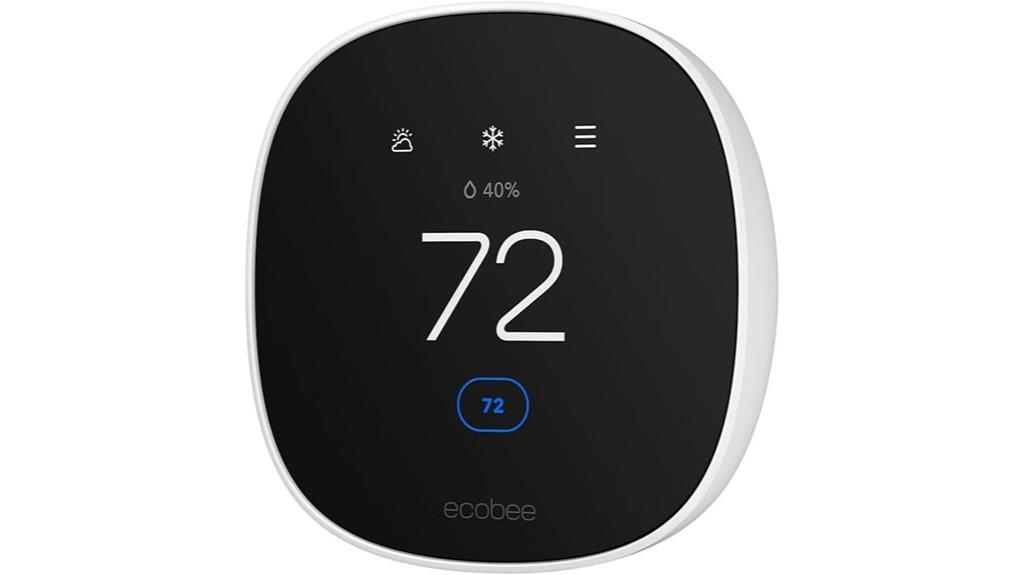
If you’re looking to optimize your home’s energy efficiency and enjoy seamless smart home integration, the ecobee Smart Thermostat Essential with Wi-Fi and Voice Assistant Compatibility is an ideal choice. It’s Energy Star certified and compatible with most HVAC systems, including gas, electric, and heat pumps. The thermostat supports Apple HomeKit, Google Assistant, and Alexa, allowing voice control and smart ecosystem integration. Its color touchscreen makes adjustments simple, and it’s designed for DIY installation, with an optional Power Extender Kit for homes without a C-wire. Plus, it offers smart features like humidity detection, scheduling, and energy-saving modes to keep your home comfortable and efficient.
Best For: homeowners seeking an energy-efficient, easy-to-install smart thermostat compatible with popular voice assistants and smart home systems.
Pros:
- Compatible with a wide range of HVAC systems including gas, electric, and heat pumps
- Supports integration with Apple HomeKit, Google Assistant, and Alexa for voice control
- Easy DIY installation with an intuitive touchscreen interface and optional Power Extender Kit
Cons:
- Price may be higher compared to basic thermostats without smart features
- Requires Wi-Fi connection for full functionality, limiting use during internet outages
- SmartSensor is sold separately, which may increase overall cost for complete home monitoring
Sensi Smart Thermostat with Wi-Fi and Mobile App
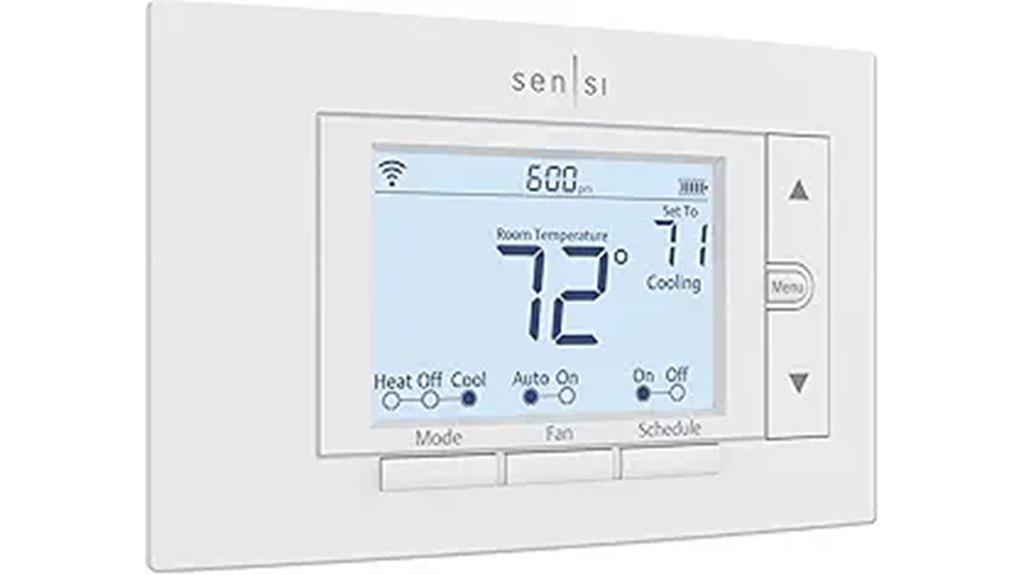
The Sensi Smart Thermostat with Wi-Fi and Mobile App stands out as an ideal choice for homeowners seeking easy, DIY installation combined with energy-saving features. With over a century of HVAC expertise from Emerson, it offers seamless Wi-Fi connectivity, remote control, and compatibility with Alexa, Google Assistant, and more. Its simple setup requires no c-wire in most cases, and the sleek 5-inch LED display makes adjustments straightforward. Certified Energy Star, it can cut HVAC energy use by about 23%. Plus, it monitors system performance, providing maintenance alerts and usage reports—all while prioritizing user privacy with no data selling.
Best For: homeowners seeking an easy-to-install, energy-efficient smart thermostat with remote control and voice assistant compatibility.
Pros:
- Easy DIY installation with no c-wire needed in most cases
- Energy Star certified, helping to reduce HVAC energy consumption by approximately 23%
- Compatible with popular voice assistants like Alexa and Google Assistant
Cons:
- Limited to standard wall spaces, which may not fit all home setups
- Requires Wi-Fi connection for full functionality, so offline use is limited
- Some users may find the app setup process or troubleshooting challenging
Honeywell T9 Smart Thermostat with Room Sensor (Renewed)

For homeowners seeking precise temperature control and energy savings, the Honeywell T9 Smart Thermostat with Room Sensor (Renewed) stands out by automatically adjusting settings based on occupancy and schedules. It offers remote control via the Honeywell Home app or voice assistants like Alexa, Google, and Apple HomeKit. The included Smart Room Sensors detect occupancy, focusing comfort on specific rooms such as bedrooms. This helps improve sleep quality and reduce energy waste. The thermostat also features geofencing, Auto Home/Away Scheduling, and auto changeover. Its sleek LED display and customizable color add a modern touch, making it a smart, efficient upgrade for any connected home.
Best For: homeowners who want precise, energy-efficient temperature control with remote and voice-assisted operation, especially in multi-room setups.
Pros:
- Includes Smart Room Sensors for targeted comfort and energy savings
- Compatible with popular voice assistants like Alexa, Google, and Apple HomeKit
- Features customizable LED display and programmable color for a modern aesthetic
Cons:
- Requires a C-wire for installation, which may not be available in all homes
- Does not support electric baseboard heating systems (120-240V)
- As a renewed product, it may have minor cosmetic imperfections or limited warranty coverage
Honeywell Smart Room Sensor for WIFI Thermostats
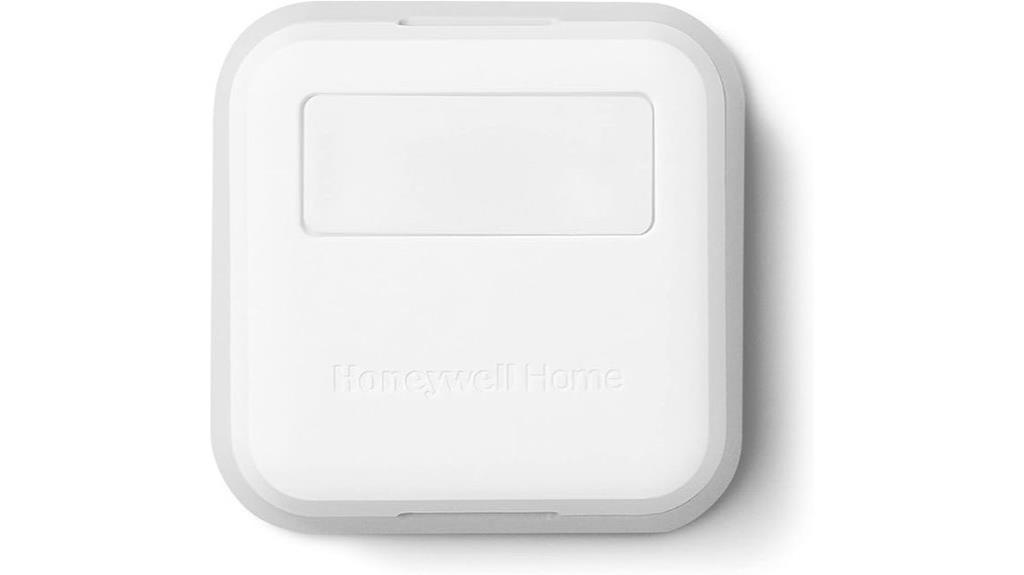
When aiming to optimize comfort across multiple rooms, the Honeywell Smart Room Sensor for Wi-Fi thermostats stands out as an ideal choice. It’s compatible with T9 and T10 Wi-Fi Smart Thermostats, allowing precise temperature and humidity sensing in different areas. The sensor detects motion to distinguish between passing through and occupancy, ensuring accurate comfort adjustments. Easy to install with no tools required, it connects via the Resideo app and works with popular smart assistants like Alexa and Google. Placed in key rooms, it helps create a comfortable environment by focusing on where people are, all while supporting scheduling and remote management.
Best For: Homeowners seeking easy-to-install, multi-room temperature and humidity control with smart integration for enhanced comfort and energy efficiency.
Pros:
- Compatible with T9/T10 Wi-Fi Smart Thermostats, supporting multi-room focus and occupancy-based adjustments.
- Easy DIY installation with no tools required, connecting via the Resideo app for remote control.
- Works with popular smart assistants like Alexa, Google Assistant, and Apple Home for seamless voice and automation integration.
Cons:
- Limited to compatible Honeywell T9/T10 series thermostats, not suitable for other models.
- Requires batteries (included) which need replacement over time.
- Some users report that motion detection sensitivity may vary depending on placement and room lighting.
Google Nest Learning Thermostat and Temperature Sensor (4th and 2nd gen)

If you want to optimize comfort and energy efficiency in a smart home, the Google Nest Learning Thermostat with remote sensors is an excellent choice. The 4th gen model features a large, vibrant display with Dynamic Farsight, making information easy to read from across the room. Its sleek, round touchscreen design combines style with user-friendliness. It works with most 24V systems and connects seamlessly via Wi-Fi to the Google Home app, supporting voice assistants like Alexa, Siri, and Google Assistant. The thermostat learns your routines, adjusts for outdoor conditions, and reduces energy costs by up to 15%, especially when paired with compatible Nest Temperature Sensors.
Best For: homeowners seeking an intelligent, energy-efficient thermostat that seamlessly integrates with smart home systems and adapts to their routines.
Pros:
- Advanced learning capabilities that optimize comfort and reduce energy costs by up to 15%
- Large, vibrant display with Dynamic Farsight for easy reading from across the room
- Supports a wide range of 24V systems and integrates with major voice assistants like Alexa, Siri, and Google Assistant
Cons:
- Requires Wi-Fi connection for full functionality, which may not be ideal in all environments
- Installation may be challenging without proper wiring or compatibility checks, especially for non-standard systems
- The device’s premium features and sensors come at a higher price point compared to basic thermostats
Amazon Smart Thermostat
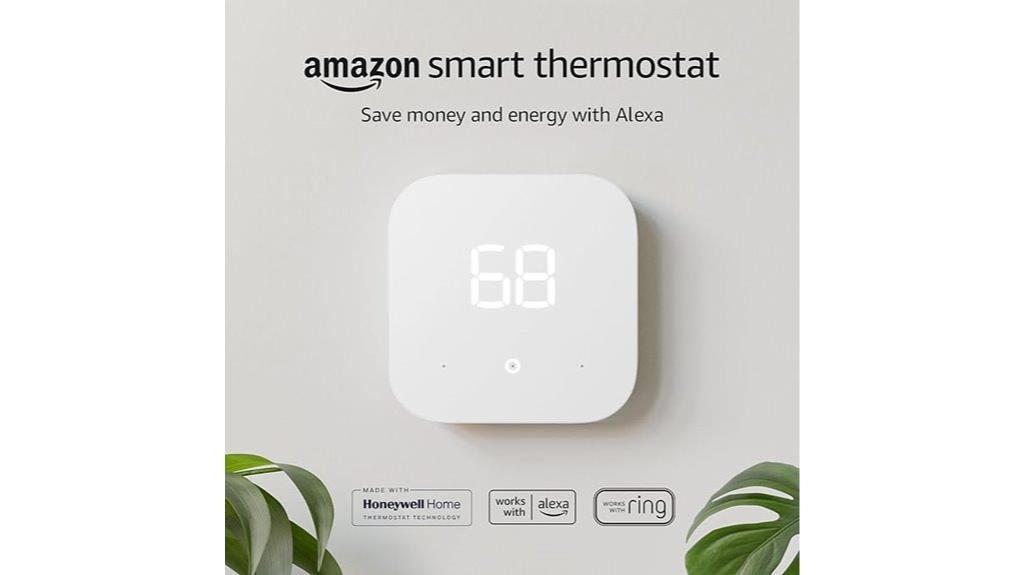
The Amazon Smart Thermostat is an excellent choice for homeowners seeking an easy, energy-saving upgrade that works seamlessly with their existing smart home devices. It simplifies installation and offers automatic adjustments based on temperature readings and presence detection, helping reduce energy bills—averaging about $50 annually. Using Alexa, you can control your thermostat remotely via the app or voice commands, switching between modes like home, away, and sleep effortlessly. Compatible with most 24V HVAC systems, it’s ENERGY STAR certified, eco-friendly, and supports scheduling and indoor humidity sensing. Its compact design and user-friendly setup make it a practical, efficient upgrade for any smart home.
Best For: homeowners seeking an easy-to-install, energy-efficient smart thermostat that integrates seamlessly with Alexa and existing 24V HVAC systems.
Pros:
- Simple installation with guided setup via the Alexa app
- Automatically adjusts temperature based on presence detection and activity patterns
- Supports remote control and voice commands through Alexa, enhancing convenience
Cons:
- Not compatible with 110-240V systems like electric baseboard heating
- Requires a C-wire or separate power adapter for operation
- Does not support 5GHz Wi-Fi networks, limiting connectivity options
LEVOIT Smart Thermostat for Home with WiFi and Alexa Compatibility
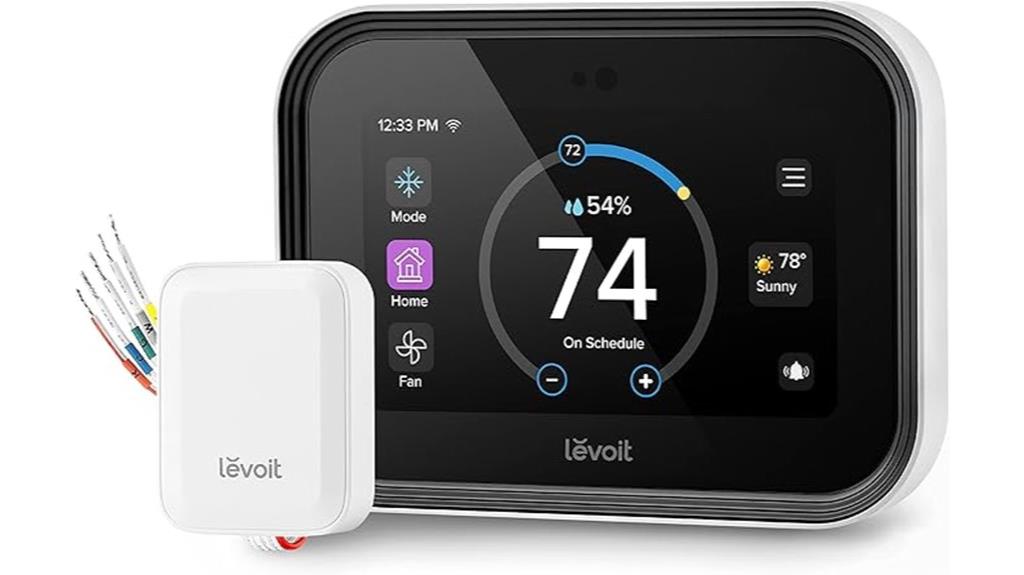
The LEVOIT Aura 400S Smart Thermostat stands out for its ability to support up to 16 remote sensors, making it ideal for users who want precise, room-by-room climate control. With WiFi and Alexa compatibility, it allows remote management via the VeSync app or voice commands. Its sleek 4-inch LCD touchscreen auto-adjusts brightness and displays real-time temperature, humidity, and weather updates. Compatible with various HVAC systems like furnaces, heat pumps, and boilers, it offers customizable schedules, eco mode, and energy reports to boost efficiency. Easy to install in about 30 minutes, it’s a versatile choice for tailored comfort and smarter energy use.
Best For: users seeking precise room-by-room climate control with easy remote management and compatibility with smart home systems.
Pros:
- Supports up to 16 remote sensors for customized room comfort
- Compatible with Alexa, Google Assistant, and ZigBee for versatile voice and app control
- Features a sleek 4-inch LCD touchscreen with auto-brightness and real-time weather updates
Cons:
- Not suitable for heating-only or high-voltage systems (120V-240V)
- Average customer rating is 3.9/5 stars, indicating some user dissatisfaction
- Installation may require some technical familiarity despite being marketed as easy
meross Smart Thermostat with WiFi and Voice Control

For those seeking a smart thermostat that seamlessly integrates with existing HVAC systems and offers remote control via Wi-Fi and voice commands, the meross Smart Thermostat with WiFi and Voice Control is an excellent choice. It supports 95% of HVAC systems, including conventional heating, cooling, and heat pumps, but requires a C-wire and only works on 2.4GHz Wi-Fi networks. Its sleek design features an LED display and programmable schedules, plus Matter support for easy integration with Apple Home, Alexa, Google Assistant, and SmartThings. Installation is simple, often taking just 10-15 minutes, and users praise its reliable performance, user-friendly app, and energy-saving features.
Best For: homeowners and DIY enthusiasts seeking an easy-to-install, reliable smart thermostat compatible with most HVAC systems and integrated with popular voice assistants.
Pros:
- Supports 95% of HVAC systems, including conventional heating, cooling, and heat pumps
- Easy 10-15 minute installation with clear instructions and built-in level
- Integrates seamlessly with Apple Home, Alexa, Google Assistant, and SmartThings via Matter
Cons:
- Requires a C-wire for proper operation, which may not be available in all setups
- Only supports 2.4GHz Wi-Fi networks, limiting compatibility with some routers
- Lacks built-in geofencing, which can be mitigated through automations but requires additional setup
Emerson Sensi Touch Wi-Fi Smart Thermostat

If you’re looking to optimize comfort and energy savings in your home, the Emerson Sensi Touch Wi-Fi Smart Thermostat is an excellent choice, especially with its compatibility with remote sensors. Its sleek 4.3-inch color touchscreen makes it easy to control and customize your settings. The thermostat supports voice commands via Alexa, Google Assistant, and Apple HomeKit, and offers app control on Android and iOS devices. Certified by Energy Star, it helps cut HVAC energy use by about 23%. With features like auto changeover, geofence technology, and maintenance alerts, it combines convenience with efficiency. Plus, DIY installation is straightforward, and data privacy is a priority.
Best For: homeowners seeking an easy-to-install, energy-efficient smart thermostat with voice control and remote sensor compatibility.
Pros:
- User-friendly 4.3-inch touchscreen display for easy control and customization
- Compatible with popular voice assistants like Alexa, Google Assistant, and Apple HomeKit
- Energy Star certified, helping save approximately 23% on HVAC energy costs
Cons:
- Requires a common wire (c-wire) for installation, which may not be present in all systems
- Limited to AC power with one AA battery, so backup battery life may vary
- Some users may find the need for additional sensors or setup complexity for advanced features
Honeywell Wi-Fi Smart Color Thermostat

Looking for a smart thermostat that combines vibrant design with energy-saving features? The Honeywell Wi-Fi Smart Color Thermostat offers customizable color options to match your decor and a bright, easy-to-read touchscreen for simple operation. It’s Energy Star certified, helping you save on energy and costs. You can program flexible 7-day schedules or sync with utility peak rates. It supports various HVAC systems, including gas, oil, electric, hot water, steam, and heat pumps with electric backup—just check for a C-wire. Control your home remotely via the touchscreen, app, Alexa, or Google Home, making it a versatile and stylish choice.
Best For: homeowners seeking a customizable, energy-efficient smart thermostat that integrates seamlessly with voice assistants and offers remote control options.
Pros:
- Customizable color options to match home decor
- Supports flexible 7-day programmable schedules and utility peak rate syncing
- Compatible with a wide range of HVAC systems, including gas, oil, electric, hot water, steam, and heat pumps with electric backup
Cons:
- Requires a C-wire for operation, which may not be present in all homes
- Does not support electric baseboard heat (120-240V) systems
- Limited to Wi-Fi connectivity; no mention of compatibility with other smart home ecosystems beyond Alexa and Google Home
Google Nest Learning Thermostat and Sensor (4th & 2nd Gen)

The Google Nest Learning Thermostat (4th and 2nd Gen) stands out as the ideal choice for homeowners seeking precise temperature control across multiple rooms, thanks to its compatibility with additional Nest Temperature Sensors. Its sleek, modern design features a larger touchscreen with Dynamic Farsight, making it easy to see from across the room. It learns your routines, adjusts automatically, and manages hot and cold spots with sensors placed in different areas. Installation is straightforward, and control is seamless via the Google Home app, voice commands, or physical buttons. With energy-saving features and compatibility with various HVAC systems, it offers both comfort and efficiency in a stylish package.
Best For: homeowners seeking precise, customizable temperature control across multiple rooms with energy-saving features and seamless smart home integration.
Pros:
- Learns user routines and adjusts heating and cooling automatically for optimal comfort and efficiency
- Compatible with a wide range of HVAC systems and supports additional Nest Temperature Sensors for multi-room control
- Easy to install, with user-friendly controls via the Google Home app, voice commands, and physical buttons
Cons:
- Requires a 24V power supply, which may necessitate additional wiring or a C wire in some systems
- Limited to 24V systems, potentially incompatible with certain high-voltage or specialized HVAC setups
- The initial setup and learning period may take some time before fully optimizing energy savings
Factors to Consider When Choosing Smart Thermostats With Remote Sensors

When selecting a smart thermostat with remote sensors, I consider several key factors to guarantee it fits my needs. I look at sensor compatibility, my HVAC system’s support, and how I’ll connect and install the device. Budget also plays a big role in narrowing down options that offer the features I want without overspending.
Sensor Compatibility Needs
Choosing the right smart thermostat with remote sensors starts with verifying compatibility. First, confirm the thermostat supports the type of sensors you want, whether temperature, humidity, or occupancy. Check if it can handle multiple sensors at once to get a well-rounded view of your home’s climate. It’s also important to verify that the sensors work within your existing smart home system and can be controlled through the same app or platform. Pay attention to the communication protocol—Wi-Fi, ZigBee, or Z-Wave—to guarantee seamless integration. Additionally, consider power sources; some sensors run on batteries, while others are wired. Features like motion detection or humidity sensing should match your specific needs, ensuring your setup is both functional and efficient.
HVAC System Support
Ensuring your smart thermostat supports your specific HVAC system is vital for reliable operation and ideal comfort. First, confirm it’s compatible with your system type—whether it’s forced air, a heat pump, boiler, or electric baseboard—to avoid functionality issues. Next, verify that the thermostat supports your system’s voltage requirements, typically 24VAC, and check for any restrictions if you have high-voltage or specialized setups. It’s also essential to ensure the control protocols, like Wi-Fi, ZigBee, or Z-Wave, align with your existing smart home ecosystem for seamless integration. Additionally, if your system has multiple stages of heating or cooling, confirm the thermostat supports multi-stage control to manage complex configurations effectively. Finally, check that remote sensors can communicate with your HVAC system without compatibility issues, especially with custom or unique components.
Connectivity Options Available
Selecting the right connectivity option for your smart thermostat with remote sensors is essential because it affects how reliably your device communicates within your smart home system. Wi-Fi is the most common, allowing remote control via smartphone apps from anywhere with internet access. Bluetooth offers local control but limited range, suitable for smaller homes. ZigBee and Z-Wave are popular mesh protocols that integrate well with many smart home hubs, providing stable communication with other devices. Many thermostats support multiple platforms like Apple HomeKit, Google Assistant, and Amazon Alexa, enhancing voice and app control flexibility. Some newer models include Matter support, ensuring broader compatibility and reliable communication across ecosystems. Your choice impacts installation complexity, network stability, and how seamlessly your thermostat interacts with your existing smart home setup.
Installation Complexity Level
Installing a smart thermostat with remote sensors can range from a simple DIY project to a complex process that requires professional help, depending on your existing system and wiring. Many models are designed for easy setup, offering step-by-step app guidance and minimal hardware. However, if your system lacks a common C-wire, installing the thermostat can become more challenging, possibly needing an adapter or professional installation. Additionally, some units only support 2.4GHz Wi-Fi or require extra hubs, which can add setup steps. The presence of additional sensors or power extenders also increases complexity, as they require extra wiring or configuration. Overall, your experience will depend on your home’s wiring setup and the specific features of the thermostat you choose.
Budget and Cost Factors
When considering a smart thermostat with remote sensors, budget and overall costs play a significant role in your decision. Prices range from about $80 to over $250, so it’s important to find a model that fits your budget. Keep in mind that additional expenses, like C-wire adapters or installation tools, can increase the total investment. Some thermostats come in bundled packages with multiple sensors, offering better value than buying sensors separately. Energy-saving features and rebates can help offset initial costs by lowering utility bills and qualifying for incentives. Balancing your budget with desired features—such as sensor range, compatibility, and energy management—is key to choosing a cost-effective solution that keeps your home comfortable and efficient.
Frequently Asked Questions
How Do Remote Sensors Improve Energy Efficiency in Smart Thermostats?
Remote sensors improve energy efficiency by providing more accurate temperature readings across different rooms. I use them to guarantee my thermostat adjusts based on where I spend most of my time, avoiding unnecessary heating or cooling in unoccupied areas. This targeted approach reduces energy waste, saves money, and keeps my home comfortable. With sensors, I get a more precise control, making my system smarter and more efficient overall.
Can Remote Sensors Detect Humidity Levels Along With Temperature?
Absolutely, remote sensors can detect humidity levels along with temperature, acting like tiny weather stations in your home. They send real-time data to your smart thermostat, helping it adjust not just the heat or cool but also maintain ideal humidity. This dual functionality creates a more comfortable living environment, much like a skilled conductor orchestrating perfect harmony between temperature and moisture, ensuring your home feels just right all year round.
Are Remote Sensors Compatible Across Different Brands of Smart Thermostats?
Remote sensors aren’t always compatible across different brands of smart thermostats. I’ve found that most manufacturers design their sensors to work best within their own ecosystems, which can limit cross-brand compatibility. If you’re considering mixing brands, I recommend checking each product’s specifications carefully or sticking to a single brand to guarantee seamless integration and reliable performance. Compatibility varies, so it’s worth doing some research before making a purchase.
How Many Remote Sensors Can Be Connected to a Single Thermostat?
I can connect up to 20 remote sensors to a single thermostat, depending on the brand and model. For example, some Ecobee models support that many sensors, which helps evenly distribute temperature control throughout larger homes. It’s important to verify the specific thermostat’s specifications because the number of compatible sensors varies. This way, I ensure my home stays comfortable and energy-efficient everywhere.
Do Remote Sensors Require Separate Wi-Fi Connections or Setups?
Remote sensors don’t require separate Wi-Fi connections or setups. They connect directly to the smart thermostat via the same network, simplifying installation and use. I find this seamless integration super convenient because I don’t have to manage multiple networks or devices. Instead, I set up the sensors once, and they communicate effortlessly with the thermostat, ensuring your home stays comfortable and energy-efficient without extra hassle or technical worries.
Conclusion
Choosing a smart thermostat with remote sensors truly enhances your home’s comfort and efficiency. While some might believe these devices only save energy, I’ve found they also create a more consistent environment. It’s almost like they intuitively understand your needs, proving that technology can subtly improve daily living. So, I recommend considering these options—because, much like a good thermostat, life’s small adjustments often make the biggest difference.
